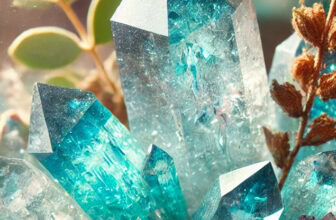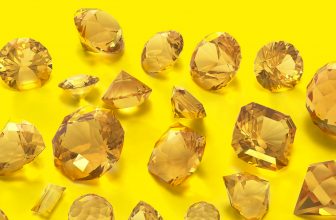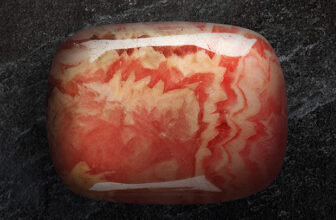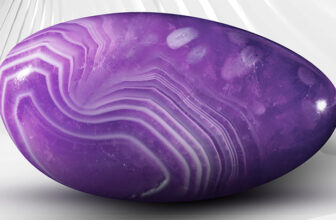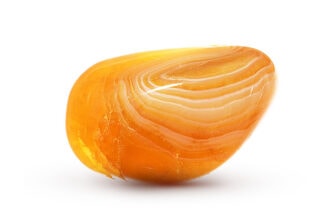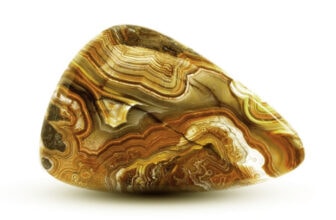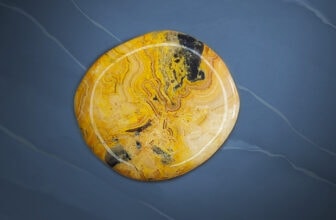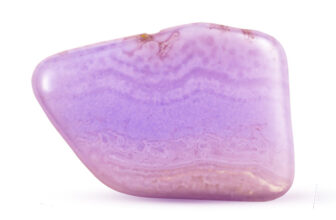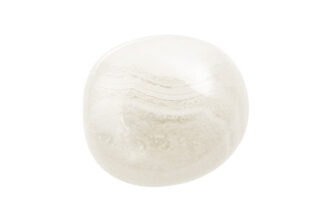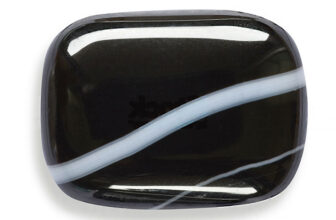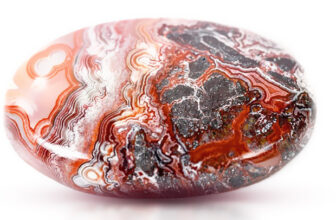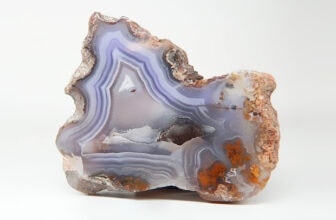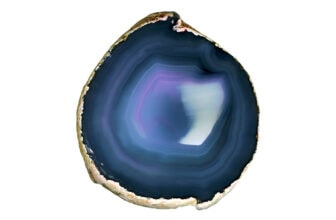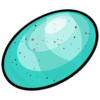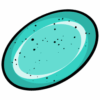The Quiet Power of Worry Stones
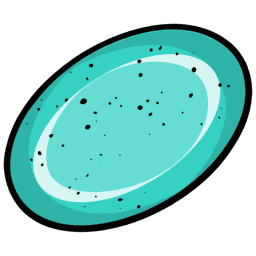 What if calming your mind could begin with something as simple as touch? A single, smooth stone, warmed by your hand, and shaped to fit perfectly beneath your thumb – that’s the essence of a worry stone. These small, polished gems are designed to be held, rubbed, and carried. They’re oval or gently flattened, often with a subtle indentation that seems made just for the human thumb.
What if calming your mind could begin with something as simple as touch? A single, smooth stone, warmed by your hand, and shaped to fit perfectly beneath your thumb – that’s the essence of a worry stone. These small, polished gems are designed to be held, rubbed, and carried. They’re oval or gently flattened, often with a subtle indentation that seems made just for the human thumb.
In a world buzzing with screens, constant alerts, and the pressure to stay “on,” worry stones offer something rare: a moment of pause. Unlike faceted gemstones that sparkle for display or large palm stones that fill the hand, worry stones are deeply personal. They’re made for interaction – for the small, repetitive movements that ground the body and quiet the mind.
The Origins of Worry Stones
Where did the first worry stone come from – and who decided that rubbing a stone could soothe the soul? The truth is, no one culture can claim the idea. The practice seems to have emerged independently across time and continents, as if humans instinctively understood the calming rhythm of touch.
In ancient Greece, people picked smooth pebbles worn down by sea tides – nature’s own polished therapy tools. These “thumb stones,” as they were sometimes called, became small companions for reflection and relaxation. Far away in Tibet, similar stones were used during chanting or meditation, the thumb tracing the same circular motion again and again, a tactile prayer.
In Ireland, pieces of soft green Connemara marble were carried as tokens against anxiety – a tradition still alive today. And among Native American tribes, stones were sometimes held during storytelling or ceremony, connecting touch with attention and presence.
Each culture named the habit differently, but the essence was the same: to hold, to feel, to focus. The term “worry stone” itself likely took hold in English-speaking countries sometime in the 20th century, aligning with the rise of psychology’s interest in fidgeting, stress, and habit loops.
Why We Reach for Worry Stones
Ever catch yourself fidgeting – tapping a pen, twisting a ring, picking at a nail – just to burn off that invisible static of stress? That’s your body’s way of searching for grounding. A worry stone offers a quieter, more intentional outlet for that same impulse.
At its simplest, the act of rubbing a worry stone engages the senses. The smooth surface under your thumb provides gentle feedback that tells your brain, you’re here, in this moment. This repetitive motion can stimulate the parasympathetic nervous system – the part responsible for slowing your heartbeat, easing your breath, and quieting that inner hum of tension. It’s tactile mindfulness, without needing to sit cross-legged or light incense.
Worry stones also stand out for their portability. They slip into a pocket, wallet, or even the small coin pouch of your bag. Unlike larger palm stones that fill the hand, worry stones are small and discreet – perfect for moments when you can’t meditate but still need to steady yourself before a meeting, an exam, or a difficult conversation.
In therapy and mindfulness circles, they’re often described as anchoring tools. When thoughts spiral, touch becomes a lifeline back to the present. Each slow rub of the thumb is like tracing your way back to calm. For those who struggle with anxiety, ADHD, or restless habits, this simple motion can redirect energy away from unhelpful fidgeting toward something soothing and centering.
And then there’s the emotional layer – the personal meaning a stone can carry. Many people choose a particular crystal because its color or metaphysical reputation resonates with them:
- Amethyst for serenity and protection.
- Rose quartz for emotional healing.
- Jasper for stability and strength.
The Many Shapes of Worry Stones
Not all worry stones are identical – though they share a family resemblance. Picture an oval no larger than a cookie, flattened and silky smooth, with a shallow indentation carved just deep enough to cradle your thumb. That dimple isn’t merely decorative; it’s functional. It guides the motion, creating a subtle groove for repetitive touch – the motion that soothes, the gesture that calms.
Classic worry stones tend to measure around 3–5 centimeters in length. They’re thin enough to feel delicate but sturdy enough for years of use. Some are perfectly symmetrical, shaped by machines to a polished gleam; others are slightly irregular, hand-tumbled from river stones or gem offcuts, carrying the quiet charm of imperfection.
Variations abound:
- Thumb stones – the standard oval with a clear indentation.
- Flat polished pebbles – no groove, just sleek surfaces for smooth rubbing.
- Mini worry stones – coin-sized pieces ideal for pocket carry or discreet use.
- Large hybrid forms – overlapping with palm stones, for those who prefer a full-hand hold.
Modern makers often play with material and finish. Some worry stones are highly polished for a mirror-like sheen; others are left matte or satin for a more organic texture. You’ll also find engraved stones etched with single words – Peace, Courage, Breathe – turning a simple shape into an intentional talisman.
Beyond the familiar ovals, there are creative offshoots: heart-shaped worry stones for gifting, teardrop styles for aesthetic appeal, and even crystal-infused resin versions for a contemporary twist. Whether made from quartz, obsidian, jade, or Irish marble, each variation carries its own feel – both physically and symbolically.
The Craft of Making a Worry Stone
Ever wonder how a rough, jagged chunk of stone becomes something so smooth it feels like water under your thumb? The making of a worry stone is an art of patience – a slow, deliberate transformation from raw mineral to tactile calm.
It all begins with selection. The artisan (or sometimes nature itself) chooses a piece of stone that’s durable yet workable – something that can handle both shaping and years of handling. Popular choices include quartz, jasper, agate, marble, and obsidian. Softer stones, like calcite or fluorite, are easier to carve but require gentler polishing; harder varieties demand more persistence and precision.
The shaping process starts with cutting the rough into a small, flat oval or free-form shape. Craftsmen often use diamond saws and grinders to sculpt the outline. Then comes the part that gives the worry stone its character – the gentle thumb indentation. This dip can be carved by hand or ground with a small rotary tool. The depth isn’t arbitrary; it’s tested by feel, ensuring it’s deep enough for comfort but shallow enough to preserve the stone’s integrity.
Next comes the sanding and polishing, a stage that can take hours. The goal isn’t just a glossy surface – it’s tactile perfection. Each step of sanding removes micro-roughness until the stone feels silky against the skin. Some artisans prefer to leave a natural matte finish for a more earthy touch, while others polish to a mirror shine that catches the light as you turn it in your hand.
Not all worry stones are carved in workshops, though. Some are gifts from nature – river pebbles smoothed by decades of tumbling water. These natural worry stones, shaped by time instead of tools, often carry a special appeal. Their softness and irregularity remind us that imperfection can still be comforting.
Choosing and Working with Worry Stones
Choosing a worry stone isn’t just about looks – it’s about connection. You’re picking something that will live in your palm, your pocket, maybe even under your pillow. So how do you find the one?
Start with feel. When you pick up a stone, does it invite your touch? Does it rest comfortably between your thumb and forefinger? The best worry stones have a natural “rightness” – a fit that feels personal, almost familiar. Trust that first instinct.
Next, look at surface quality. A well-made worry stone should be flawlessly smooth, free of cracks, pits, or sharp edges. The polish should glide beneath your skin without friction. If the stone has a thumb groove, try it out – the dip should cradle your thumb easily, not press or slip.
Then there’s material and energy. If you’re drawn to crystal meanings, choose one that aligns with your intention:
- Amethyst to ease anxiety and enhance calm.
- Rose quartz for gentleness, forgiveness, and emotional healing.
- Black obsidian for grounding and protection.
- Jasper or agate for stability and balance.
Or, if you’re less concerned with metaphysical traits, simply choose by color, texture, or the comfort it gives your senses.
As for using your worry stone – keep it simple. Slip it into your pocket or bag. When you feel restless, tense, or distracted, take it out and start to rub your thumb gently across its surface. Feel the smoothness, the warmth of the stone, the rhythm of your motion. This repetitive act isn’t about thinking – it’s about feeling your way back to calm.
You can also integrate it into mindfulness or meditation:
- Hold your stone during deep breathing and match each stroke to your inhale and exhale.
- Use it as a tactile focus while repeating a mantra or affirmation.
- Keep it nearby during work or travel as a discreet grounding aid.
What They’re Made Of: Gem Varieties and Cultural Favorites
Worry stones are less about rarity and more about resonance – but the material still matters. Each type of gemstone brings its own texture, color, and story. Here are some of the most beloved choices:
- Rose Quartz: Soft pink and soothing, this stone is often associated with self-love, compassion, and gentle healing energy. It’s the go-to choice for emotional balance.
- Amethyst: With its violet hues, amethyst is prized for calming overstimulated minds and promoting peaceful rest.
- Jasper: Often patterned in earthy reds, browns, and greens, jasper offers grounding stability – perfect for those who need a sense of rootedness in daily life.
- Obsidian: Deep black and glassy, obsidian absorbs negativity and encourages clarity. It’s a favorite for protection and mental focus.
- Aventurine: Known as the “stone of opportunity,” its soft green shimmer inspires optimism and emotional renewal.
- Agate: With its layers of color, agate brings steady, balancing energy – great for those who juggle multiple stresses at once.
Beyond these staples, there are culturally significant varieties too. Connemara marble, native to Ireland, is traditionally carved into worry stones and gifted for luck and calm. Tibetan thumb stones often feature symbolic carvings or are used alongside chanting practices.
Modern artisans have expanded the idea further – creating worry stones from glass, resin, or even clay. Some embed affirmations or symbols within the surface; others combine two minerals into a single stone for dual energy. The possibilities are as varied as the people who use them.
What Worry Stones Can (and Can’t) Do
Like all tools, worry stones have their strengths – and their limits. Understanding both can help you use them more meaningfully.
Pros:
- Tactile comfort: The rhythmic motion of rubbing a stone can soothe nerves and steady breathing – a natural sensory reset.
- Portable peace: Tiny, discreet, and pocket-sized, worry stones can travel anywhere – a private calm amid public chaos.
- Affordable mindfulness: No batteries, apps, or subscriptions required. Just a stone and your hands.
- Versatile: Works for meditation, stress relief, fidget control, or simply as a comforting keepsake.
- Meaningful connection: Choosing a stone with personal or spiritual significance makes it more than an object – it becomes a companion.
Cons:
- Fragility: Softer stones can scratch, chip, or lose polish over time, especially if carried loosely with keys or coins.
- Subtlety: They’re not meant for visual sparkle – if you crave brilliance, you may find their understated look less captivating.
- Limited evidence: While countless users swear by their calming effect, scientific proof remains anecdotal. The magic lies mostly in experience, not data.
- Not for everyone: Some people prefer active grounding methods – like walking or journaling – over quiet tactile focus.

